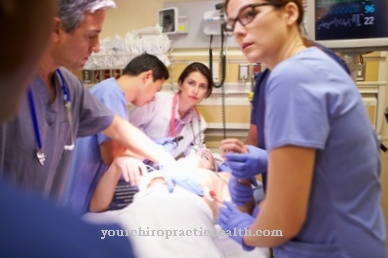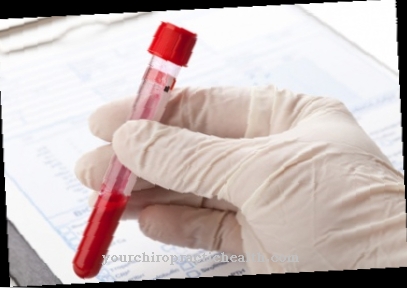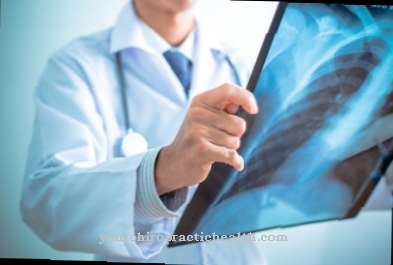The Single photon emission computed tomography (SPECT) belongs to the examination spectrum of nuclear medicine. It is their job to assess the metabolism and thus the function in different organ systems.This is made possible by a radiopharmaceutical given to the patient, whose distribution in the body is made visible in the form of cross-sectional images with the help of gamma cameras.
What is single photon emission computed tomography?

Single-photon emission computed tomography is often known under the abbreviation SPECT, which is the abbreviation for the English name of this examination (Single Photon Emission Computed Tomography) is.
It must not be confused with CT (computed tomography) because of its similar name: While CT works with X-rays and a classic contrast medium, single-photon emission computed tomography is based on the administration of a tracer (technetium-99m is most often used here), its path is followed by the body due to its radiation - harmless in the dose used - with gamma cameras, i.e. without any exposure to X-rays.
In principle, the examination proceeds like the frequently performed scintigraphy, for example of the thyroid gland or the lungs. A distinction is made between two variants of this nuclear medicine diagnostic method: With the static method, it is only measured once where the radionuclide is located in the body at the time of the examination; with the dynamic examination, changes over time are also made visible through repeated recordings.
Function, effect & goals
The task of single-photon emission computed tomography is to check the functionality of certain organ systems and to discover possible malfunctions. This is made possible with the so-called tracer, a weakly radioactive substance. The substance is usually injected into the patient's arm vein at the start of the examination, but it can also be swallowed or inhaled for special organ examinations.
The slightly radiating radionuclide spreads in the organ to be examined and sends out the weak gamma radiation there for a certain period of time. This is recorded by special cameras, the so-called gamma cameras. The cameras' measuring heads rotate around the patient's body during the examination and record the radiation from different directions. Before this, depending on the reason for the examination, a different waiting time is observed so that the tracer can optimally accumulate in the body. This enrichment is recorded by the gamma cameras and reproduced in sectional images with computer-aided calculations.
These are at least two-dimensional, sometimes even three-dimensional and for this reason form a meaningful basis for the diagnostics of the nuclear medicine doctor. In the case of questions that primarily depend on the metabolism in the organ, i.e. the course of the distribution of the radiopharmaceutical, the recording is repeated after a certain period of time, which can take minutes or hours. A common type of examination in the field of single-photon emission computed tomography is the SPECT of the heart: It gives the cardiologist important information about the blood flow in the heart muscle tissue and can also be used in conjunction with the ECG (gated SPECT).
Indications of constricted coronary arteries or cardiac insufficiency are often recognized early enough so that appropriate prophylaxis, for example to prevent a heart attack, can be initiated. Single-photon emission computed tomography assumes another important function in checking brain function: the diagnostic range is extensive, from circulatory disorders that can trigger a stroke to degenerative processes such as Parkinson's disease. Nuclear medicine examinations are also used in the examination of epilepsy patients or in the case of certain tumor diseases.
The sectional images also provide meaningful information about the metabolism in the bones, so that diagnostics can also be used in this area and, for example, in the case of inflammation or loose prostheses, provides the image basis for an adequate therapy. SPECT is also used to detect the NET, the neuroendocrine tumor that is usually found in the digestive system. A special combination is the so-called SPECT / CT, which is implemented using special devices. It combines the ability of single-photon emission computed tomography to show functional processes in the body with the advantage of CT in depicting morphological structures.
Single-photon emission computed tomography is usually performed in the supine position. Usually it does not require any special preparation. Only when examining certain organ systems may it be necessary to do this examination when the patient is fasting.
Risks, side effects & dangers
The single-photon emission computer tomography is - like the conventional scintigraphy - a very low-risk examination method. On the one hand, this is due to the fact that the patient is not exposed to any X-rays during this examination (with the exception of the special SPECT / CT examination).
In addition, instead of a classic contrast agent, which - especially with iodine-containing substances - could lead to an allergic reaction in some patients, the radioactive tracer (in many cases technetium) is used, which usually does not lead to side effects. The half-life of the radiopharmaceuticals used is very short, so that there is no danger for those who come into contact with the patient after the examination. Only close physical contact with pregnant women or small children is advised against on the day of the examination - similar to, for example, the frequently performed thyroid scintigraphy.
The nuclear medicine specialist recommends certain precautionary measures that are only relevant for a short period of time for nursing mothers. Patients who drink a lot after the examination can also accelerate the elimination of the already low level of radioactivity from their body. The SPECT device cannot be compared with the narrow and for many patients perceived as stressful tube of the MRI. Due to the open parts of the device, the single-photon emission computer tomography can also be carried out well for patients with claustrophobia.













.jpg)

.jpg)
.jpg)











.jpg)